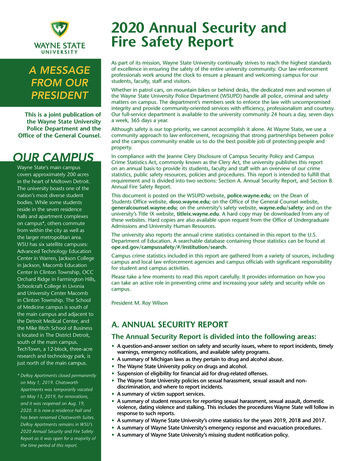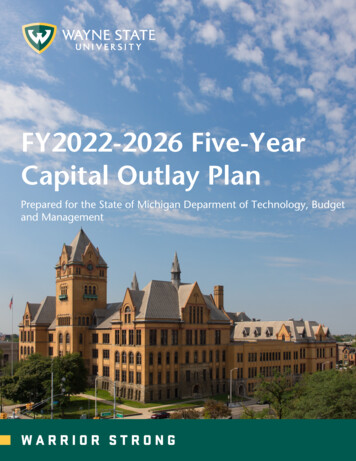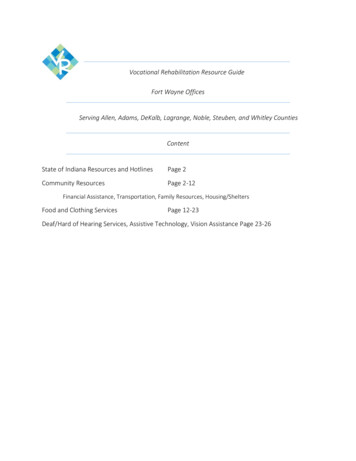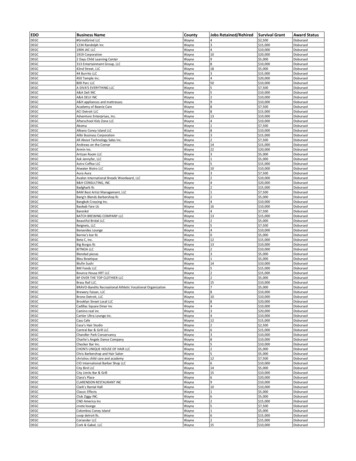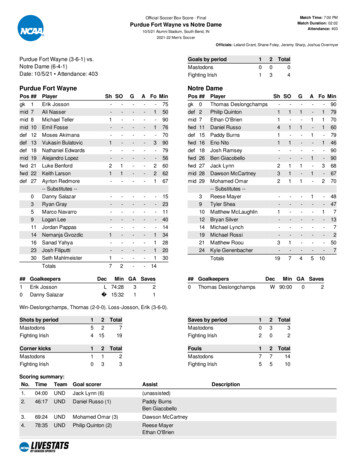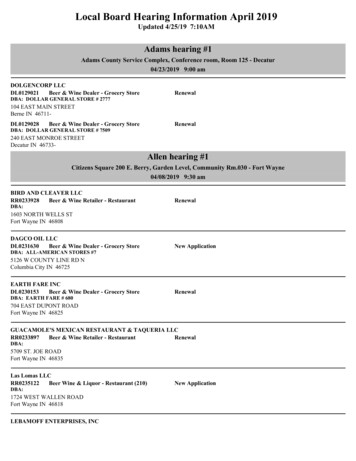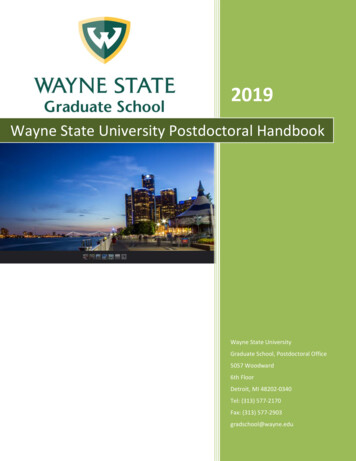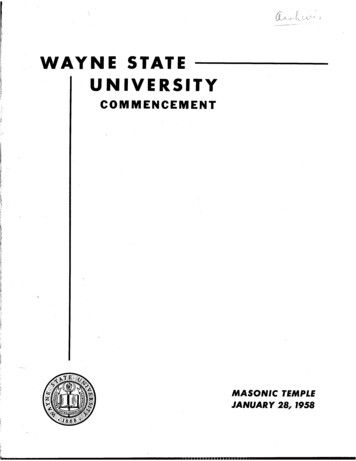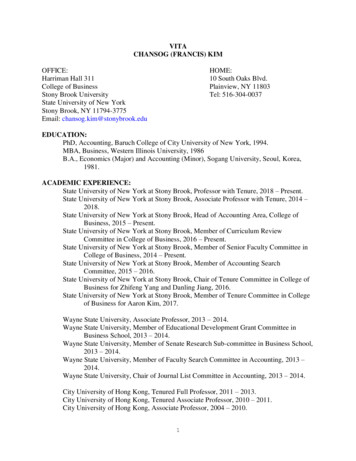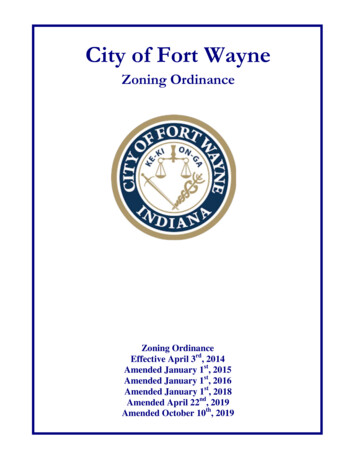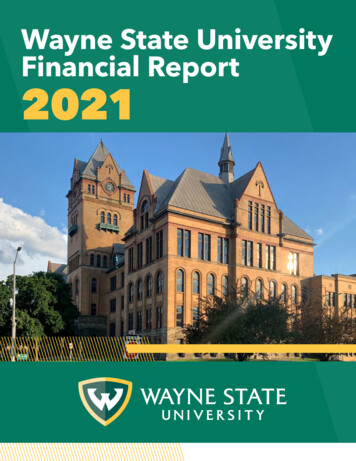
Transcription
Wayne State UniversityFinancial Report2021
Executive OfficersM. Roy WilsonPresidentStephen M. LanierVice President for ResearchMark L. KornbluhProvostLouis LessemVice President andGeneral CounselSusan E. BurnsVice President for Developmentand Alumni AffairsDavid P. MassaronVice President for Finance andBusiness Operations, Treasurerand Chief Financial OfficerPatrick O. LindseyVice President for Governmentand Community AffairsJulie H. MillerVice President and Secretaryto the Board of GovernorsNed StaeblerVice President forEconomic DevelopmentMichael WrightChief of Staff and Vice President forMarketing and CommunicationsBoard of GovernorsBryan C. Barnhill IIMarilyn Kelly, chairDana ThompsonMichael J. BusuitoAnil KumarShirley StancatoMark GaffneyTerri Lynn LandM. Roy Wilson, ex officioFinance AdministratorsDavid P. MassaronVice President, Treasurerand Chief Financial OfficerMarianne CunninghamAssistant Vice President,Treasury and Assistant TreasurerTony L. MillerInterim Senior Director and AssociateControllerTamaka M. ButlerInterim Senior Associate Vice Presidentfor Finance and Deputy CFOColleen CiliaDirector of AccountingGail L. RyanAssociate Vice President forSponsored Program Administration
Wayne State UniversityContentsIndependent Auditor’s Report1-2Management’s Discussion and Analysis - Unaudited3-18Financial StatementsStatement of Net Position19Statement of Revenues, Expenses, and Changes in Net Position20Statement of Cash Flows21Notes to Financial StatementsRequired Supplementary Information - UnauditedSchedule of Changes in the University's Total OPEB Liability and Related RatiosSupplemental InformationCombining Statement of Net Position (Deficit)Combining Statement of Revenues, Expenses, Transfers, and Changesin Net Position (Deficit)Combining Statement of Net Position (Deficit) - 2020Combining Statement of Revenues, Expenses, Transfers, and Changesin Net Position (Deficit) - 202022-515253545556-575859-60
Independent Auditor's ReportTo the Board of GovernorsWayne State UniversityReport on the Financial StatementsWe have audited the accompanying financial statements of the business-type activities and the discretelypresented component unit of Wayne State University (the "University") as of and for the years ended September30, 2021 and 2020 and the related notes to the financial statements, which collectively comprise Wayne StateUniversity's basic financial statements, as listed in the table of contents.Management’s Responsibility for the Financial StatementsManagement is responsible for the preparation and fair presentation of these financial statements in accordancewith accounting principles generally accepted in the United States of America; this includes the design,implementation, and maintenance of internal control relevant to the preparation and fair presentation of financialstatements that are free from material misstatement, whether due to fraud or error.Auditor’s ResponsibilityOur responsibility is to express opinions on these financial statements based on our audits. We conducted ouraudits in accordance with auditing standards generally accepted in the United States of America and the standardsapplicable to financial audits contained in Government Auditing Standards, issued by the Comptroller General ofthe United States. Those standards require that we plan and perform the audits to obtain reasonable assuranceabout whether the financial statements are free from material misstatement.An audit involves performing procedures to obtain audit evidence about the amounts and disclosures in thefinancial statements. The procedures selected depend on the auditor’s judgment, including the assessment of therisks of material misstatement of the financial statements, whether due to fraud or error. In making those riskassessments, the auditor considers internal control relevant to the entity’s preparation and fair presentation of thefinancial statements in order to design audit procedures that are appropriate in the circumstances, but not for thepurpose of expressing an opinion on the effectiveness of the entity’s internal control. Accordingly, we express nosuch opinion. An audit also includes evaluating the appropriateness of accounting policies used and thereasonableness of significant accounting estimates made by management, as well as evaluating the overallpresentation of the financial statements.We believe that the audit evidence we have obtained is sufficient and appropriate to provide a basis for our auditopinions.OpinionsIn our opinion, the financial statements referred to above present fairly, in all material respects, the respectivefinancial position of the business-type activities and the discretely presented component unit of Wayne StateUniversity as of September 30, 2021 and 2020 and the respective changes in its financial position and, whereapplicable, cash flows for the years then ended in accordance with accounting principles generally accepted in theUnited States of America.1
To the Board of GovernorsWayne State UniversityOther MattersRequired Supplemental InformationAccounting principles generally accepted in the United States of America require that the management'sdiscussion and analysis and schedule of changes in the University's total OPEB liability and related ratios bepresented to supplement the basic financial statements. Such information, although not a part of the basicfinancial statements, is required by the Governmental Accounting Standards Board, which considers it to be anessential part of financial reporting for placing the basic financial statements in an appropriate operational,economic, or historical context. We have applied certain limited procedures to the required supplementalinformation in accordance with auditing standards generally accepted in the United States of America, whichconsisted of inquiries of management about the methods of preparing the information and comparing theinformation for consistency with management's responses to our inquiries, the basic financial statements, andother knowledge we obtained during our audit of the basic financial statements. We do not express an opinion orprovide any assurance on the information because the limited procedures do not provide us with sufficientevidence to express an opinion or provide any assurance.Other InformationOur audits were conducted for the purpose of forming opinions on the financial statements that collectivelycomprise Wayne State University's basic financial statements. The other supplemental information, as identified inthe table of contents, is presented for the purpose of additional analysis and is not a required part of the basicfinancial statements.The other supplemental information is the responsibility of management and was derived from and relates directlyto the underlying accounting and other records used to prepare the basic financial statements. Such informationhas been subjected to the auditing procedures applied in the audit of the basic financial statements and certainadditional procedures, including comparing and reconciling such information directly to the underlying accountingand other records used to prepare the basic financial statements or to the basic financial statements themselves,and other additional procedures in accordance with auditing standards generally accepted in the United States ofAmerica. In our opinion, the other supplemental information is fairly stated in all material respects in relation to thebasic financial statements as a whole.Other Reporting Required by Government Auditing StandardsIn accordance with Government Auditing Standards, we have also issued our report dated February 21, 2022 onour consideration of Wayne State University's internal control over financial reporting and on our tests of itscompliance with certain provisions of laws, regulations, contracts, grant agreements, and other matters. Thepurpose of that report is to describe the scope of our testing of internal control over financial reporting andcompliance and the results of that testing, and not to provide an opinion on the internal control over financialreporting or on compliance. That report is an integral part of an audit performed in accordance with GovernmentAuditing Standards in considering Wayne State University's internal control over financial reporting andcompliance.February 21, 20222
Wayne State UniversityManagement’s Discussion and Analysis - UnauditedIntroductionThe following discussion and analysis provides an overview of the financial position of Wayne StateUniversity (the “University”) at September 30, 2021 and the results of its operations and cash flows for theyear then ended. Comparative information is provided as of and for the year ended September 30, 2020.This discussion has been prepared by management and should be read in conjunction with theaccompanying financial statements and related notes to facilitate and enhance the reader’s understandingof the 2021 financial report.Wayne State University is a nationally recognized public research university with urban roots and a globalreputation. The main campus, located in Detroit’s University Cultural Center, includes more than 350undergraduate, graduate, doctoral, certificate, and professional programs offered through the University’sschools and colleges. The University ranks among the top public universities in the nation and has the mostdiverse student body of any university in Michigan. As the 12th largest employer in the city of Detroit, asranked by the 2021 Crain’s Business Survey of Detroit’s Largest Employers, the University has a significantimpact on the local economy and contributes to the state and nation as well through its research and publicservice programs.Excellence in research is essential to the University’s mission. Based on the 2020 National ScienceFoundation Research and Development Expenditures Survey, the University ranked 104th among alluniversities and 70th among public universities in research and development expenditures. A substantialportion of the University’s research is conducted at the School of Medicine, the nation’s largest singlecampus medical school. The 2020 National Science Foundation Research and Development ExpendituresSurvey ranked the University 53rd in the health sciences category. Based on the 2021 Carnegieclassification of higher education, Wayne State University ranked within the top 3.0 percent of the nation’suniversities and colleges with the Carnegie classification of R1 (very high research activity). Wayne StateUniversity, Michigan State University, and the University of Michigan, the state’s three largest researchuniversities, are partners in the University Research Corridor (URC). The URC is an alliance among thesethree universities to spark regional economic development through invention, innovation, and technologytransfer, by educating a work force prepared for the “knowledge economy,” and by attracting smart andtalented people to Michigan.Using this ReportThe University’s financial report includes three financial statements: the statement of net position; thestatement of revenue, expenses, and changes in net position; and the statement of cash flows. The reportalso includes notes to the financial statements, which are an integral component of the report, and requiredsupplementary information (RSI). These financial statements, accompanying notes, and RSI are preparedin accordance with the principles of the Governmental Accounting Standards Board (GASB). Consistentwith the GASB principles, the Wayne State University Foundation (the “Foundation”), as a controlledcorporate organization, is a discretely presented component unit (DCU) of the University. The Foundation’sstatement of financial position and statement of activities and changes in net position are discretelypresented in the University’s financial statements. The management’s discussion and analysis refers to theUniversity only (excluding the Foundation), unless otherwise noted. Additional supplemental information,which provides the statement of net position and operating information for the various funds of theUniversity, is also included in the report.3
Wayne State UniversityManagement’s Discussion and Analysis - Unaudited (Continued)Novel Coronavirus (COVID-19) PandemicIn March 2020, the global outbreak of COVID-19, a respiratory disease caused by a new strain ofcoronavirus was declared a pandemic by the World Health Organization, and a national emergency by thePresident of the United States. In response, federal and state governments have implemented measuresto combat the outbreak which have impacted business operations worldwide. Likewise the pandemic hashad a significant impact on the University during fiscal year 2021 and 2020. Effective March 16, 2020, theUniversity cancelled all in-person classes for the remainder of the winter semester and remote instructionbegan for all classes on March 23, 2020. The University reduced the scope of its on-site operations andwhere possible, certain employees teleworked from their homes. In addition, the University limited oncampus residence, all non-essential travel, and cancelled or postponed athletic or other on-campusconferences or events. Classes remained remote throughout spring/summer 2020 semester. Althoughtraditional on campus classes were offered in Fall 2020, the majority of classes remained remote inacademic year 2020-2021. All on campus face-to-face instruction was suspended from November 2020through January 2021 and again in April 2021. In Fall 2021, approximately 30 percent of the courses wereoffered in a traditional face to face format while the remaining courses were either remote or hybrid. Thefollowing sections will discuss further the specific impacts reflected in the financial statements for the yearending September 30, 2021 and 2020.Overall Financial HighlightsThe University’s financial position at September 30, 2021 includes assets and deferred outflows ofresources of approximately 1.93 billion and liabilities and deferred inflows of resources of 1.21 billion.Net position, which represents the residual interest in the University’s assets and deferred outflows ofresources after liabilities and deferred inflows of resources are deducted, was 0.7 billion as ofSeptember 30, 2021.Financial PositionThe summary table below shows the University’s assets, deferred outflows of resources, liabilities, deferredinflows of resources, and net position at September 30 for the past three fiscal years:2021Total assets 2020(in millions)20191,923.6 1,861.7 14.114.613.7969.3971.8819.5Deferred inflows of resources244.0254.6226.2Net position724.4649.9661.8Deferred outflows of resourcesTotal liabilities1,693.8Specific discussion and analysis of the changes in the components of the assets, deferred outflows ofresources, liabilities, deferred inflows of resources, and net position categories are provided on pages 5-9.4
Wayne State UniversityManagement’s Discussion and Analysis - Unaudited (Continued)OperationsA summary of revenue and expenses, including the operating, nonoperating, and other categories for theyears ended September 30, 2021, 2020, and 2019 is as follows:2021Revenue:Operating revenuesNonoperating revenuesOtherTotal revenuesExpenses:Operating expensesNonoperating expensesTotal expenses2020 565.2373.32.7(in millions) 562.8312.17.6 941.2 846.320.4 866.72019 585.6304.61.2882.5 891.4 869.225.2 875.321.0 894.4 896.3During fiscal year 2021, total revenue increased 58.7 million (6.7 percent) compared to 2020, while totalexpenses decreased 27.7 million (3.1 percent). During fiscal year 2020, total revenue decreased 8.9million (1.0 percent) compared to 2019, while total expenses decreased 1.9 million (0.2 percent). Specificdiscussion and analysis of the changes in the components of the revenue and expense categories areprovided on pages 10-17.Statement of Net PositionThe statement of net position presents the financial position of the University at the end of each fiscal yearand includes all assets, deferred outflows of resources, liabilities, and deferred inflows of resources of theUniversity. Net position is one key indicator of the current financial position of the University, while thechange in net position is a key indicator of how the current year’s operations affected the overall financialcondition of the University. Assets, deferred outflows of resources, deferred inflows of resources, andliabilities are generally measured using current values. One notable exception is capital assets, which arestated at historical cost less accumulated depreciation.5
Wayne State UniversityManagement’s Discussion and Analysis - Unaudited (Continued)A summarized comparison of the University’s assets, deferred outflows of resources, liabilities, deferredinflows of resources, and net position at 2021, 2020, and 2019 is as follows:2021Current assetsNoncurrent assets:InvestmentsCapital assets - Net of depreciationOther Total assetsDeferred outflows of resourcesCurrent liabilitiesNoncurrent liabilities:Long-term debt - Net of current portionOtherTotal liabilitiesDeferred inflows of resourcesTotal net position 2020697.5 2019(in millions)609.9 226.2724.4 649.9 661.8Current Assets and LiabilitiesCurrent assets are comprised primarily of cash and cash equivalents, current investments, and receivables.In 2021, current assets increased 87.6 million (14.4 percent) to 697.5 million compared to 609.9 millionat September 30, 2020. This increase consisted of an increase in cash and cash equivalents and currentinvestments of 49.7 million, an increase in current receivables of 37.8 million, and an increase in otherassets of 0.1 million. Changes in cash and cash equivalents and current investments are the result of theUniversity’s overall operating performance and timing. The increase in net current receivables resultedlargely from an increase in net grants and contracts receivable of 21.8 million which was attributableprincipally to eligible costs incurred for federal economic relief grants which were not reimbursed as ofSeptember 30, combined with increases in net student accounts receivable of 2.6 million, stateappropriations receivable of 2.1 million, and a combined total of the other net receivables of 11.3 million.In 2020, current assets increased 8.4 million (1.4 percent) to 609.9 million compared to 601.5 million atSeptember 30, 2019. This increase consisted of an increase in cash and cash equivalents and currentinvestments of 5.4 million, an increase in prepaid expenses and deposits of 7.2 million, and an increasein other assets of 0.1 million, partially offset by a decrease in net current receivables of 4.3 million. Theincrease in prepaid expenses and deposits resulted largely from an increase in prepaid payroll ( 4.8 million)for compensation paid as of September 30, for service periods in the subsequent fiscal year, combined withan increase in other prepaid expenses and deposits ( 2.4 million).6
Wayne State UniversityManagement’s Discussion and Analysis - Unaudited (Continued)Current liabilities are comprised of amounts payable within one year and consist primarily of accountspayable, accrued liabilities, and unearned revenue. In 2021, total current liabilities increased by 18.5million (5.7 percent) to 341.3 million compared to 322.8 million at September 30, 2020. The increaseconsisted of increases in accounts payable and accrued liabilities of 9.4 million, unearned revenue of 2.1million, deposits of 1.6 million, and the current portion of long-term debt of 5.4 million. The increase inaccounts payable and accrued liabilities was largely due to the deferral of employment tax paymentsauthorized by the CARES Act, combined with an increase in accrued payroll due to the timing of the 2021year-end pay date which resulted in the accrual of one additional day and one-time payments related to abargaining unit agreement which was paid subsequent to fiscal year-end.In 2020, total current liabilities increased by 9.1 million (2.9 percent) to 322.8 million compared to 313.7million at September 30, 2019. The increase consisted of increases in accounts payable and accruedliabilities of 12.4 million and unearned revenue of 0.3 million, partially offset by decreases in the currentportion of long-term debt of 3.4 million and deposits of 0.2 million. The increase in accounts payable andaccrued liabilities was largely due to the timing of disbursements for certain program funds ( 11.3 million)collected by the University in an agency capacity that were disbursed to program participants subsequentto September 30 in 2020, whereas in 2019, the funds were disbursed prior to fiscal year-end.The University’s current ratio (current assets divided by current liabilities), a measure of liquidity, was 2.0,as of September 30, 2021 and 1.9 as of September 30, 2020 and 2019.Deferred Outflow of ResourcesDeferred outflow of resources totaled 14.1 million in 2021, compared to 14.6 million in 2020, and 13.7million in 2019. The deferred outflow includes OPEB related amounts of 1.8 million and 1.5 million in2021 and 2020, and amounts related to losses recognized in the defeasance of debt of 12.4 million and 13.1 million, in 2021 and 2020, respectively. The amount in 2019 relate, principally, to losses recognizedin the defeasance of debt.Deferred Inflow of ResourcesDeferred inflow of resources totaled 244.0 million in 2021, compared to 254.6 million and 226.2 millionin 2020 and 2019, respectively. The 2021 amount includes 240.7 million related to the service concessionarrangement (more fully discussed in Note 15), 1.5 million related to the defeasance of debt, 1.3 millionfor OPEB-related amounts, and 0.5 million related to an irrevocable split-interest agreement. The 2020amount includes 246.8 million related to the service concession arrangement, 4.3 million related to afiscal year 2021 state appropriations payment received in fiscal year 2020, 1.7 million related to thedefeasance of debt, 1.3 million for OPEB-related amounts, and 0.5 million related to an irrevocable splitinterest agreement.Noncurrent Assets and LiabilitiesNoncurrent AssetsNoncurrent assets are comprised primarily of investments, capital assets, and noncurrent receivables.Notable changes from 2020 to 2021 in noncurrent assets include a decrease in investments of 40.4 millionand an increase in net capital assets of 17.4 million.7
Wayne State UniversityManagement’s Discussion and Analysis - Unaudited (Continued)InvestmentsNoncurrent investments are comprised primarily of the Endowment Fund and Plant Fund investments. TheEndowment Fund investments consist of gift annuity, life income funds, and endowments not managed bythe Foundation. Investments in the Plant Fund consist primarily of invested bond proceeds and relatedearnings, which are restricted for capital projects. The invested bond proceeds and the majority of theseendowment fund investments are managed by the University.The composition of noncurrent investments at September 30, 2021, 2020, and 2019 are as follows:202120202019(in millions)Endowment Fund Plant Fund - Restricted invested bond proceeds8.0 6.7184.41.51.5Other restricted investmentsTotal noncurrent investments 142.7152.2 192.6 6.258.4- 64.6The 2020 invested bond proceeds component of noncurrent investments represents proceeds of 216.5million for the Series 2019A, Series 2019B, and the Series 2020 Bonds, issued during fiscal year 2020 andproceeds of 133.0 million from the Series 2018A Bonds issues in fiscal year 2018, net of bond refundingand expenditures for related capital projects and the current portion of restricted invested bond proceeds.The invested bond proceeds component of noncurrent investments decreased 41.7 million in 2021 asfunds were spent for planned capital projects.Foundation InvestmentsThe Foundation manages approximately 99 percent of the University’s endowment funds. The compositionof the Foundation’s noncurrent investments at September 30, 2021, 2020, and 2019 are as follows:202120202019(in millions)Endowment Fund investments 514.4 417.2 394.3In 2021, the Foundation Endowment Fund investments increased 97.2 million (23.3 percent) to 514.4million. The 2021 increase is principally because of a net investment gain ( 98.0 million) and new gifts( 13.3 million), offset partially by net distributions to the University ( 17.8 million).In 2020, the Foundation Endowment Fund investments increased 22.9 million (5.8 percent) to 417.2million. The 2020 increase is principally because of a net investment gain ( 27.2 million) and new gifts( 10.2 million), offset partially by net distributions to the University ( 16.0 million).Capital AssetsOne factor critical to enhancing the quality of the University’s academic and research programs andresidential life is the development and renewal of its capital assets. The University continues to modernizeits older teaching, research, and administrative buildings as well as construct new facilities.8
Wayne State UniversityManagement’s Discussion and Analysis - Unaudited (Continued)Capital additions during 2021 totaled 82.8 million, compared to 97.0 million in 2020 and 130.6 million in2019. The 2021 capital additions include expenditures for the construction of a new Basketball Arena ( 17.5million), the Hillberry Gateway Performance Complex expansion, construction, and renovation project( 17.9 million), the purchase of a medical office building ( 16.2 million), as well as renovations andupgrades to many other university buildings.The 2020 capital additions include expenditures for the Chatsworth renovation ( 27.3 million), therenovation and repurposing of the Science and Engineering Library ( 20.0 million), the construction of anew Basketball Arena ( 7.9 million) and the Hillberry Gateway Performance Complex expansion,construction, and renovation project ( 4.3 million)Capital asset additions are funded primarily with bond proceeds, gifts, state capital appropriations, serviceconcessionaire arrangements, and unrestricted net assets designated for capital purposes.Noncurrent LiabilitiesNotable changes in the noncurrent liability section of the statement of net position from 2020 to 2021included a decrease in long-term debt (net of the current portion) of 17.6 million, partially offset by adecrease in other noncurrent liabilities of 3.4 million.Long-term DebtTotal long-term debt (including the current portion) totaled 598.0 million, 610.1 million, and 464.8 million,at September 30, 2021, 2020, and 2019, respectively.For 2021, total long-term debt decreased 12.1 million, which primarily represented principal paymentsmade during the year.In its role of financial steward, the University works to manage its financial resources effectively, includingthe use of debt to finance capital projects. In October 2019, the University issued its tax exempt series2019A ( 76.3 million) and taxable series 2019B Bonds ( 25.7 million). The 2019A Bonds were issued tofund various university projects and to refund the Series 2009A and Series 2009B Bonds. The Series 2019BBonds were issued to fund the construction of a new Basketball arena. In July 2020, the University issuedits taxable Series 2020A Bonds ( 115.0 million) to fund the renovation of State Hall and other capitalprojects. The bonds issued in fiscal year 2020 are more fully discussed in Note 6 to the financial statements.Net PositionNet position represents the difference between assets, deferred outflows of resources, deferred inflows ofresources, and liabilities. The University’s net position at September 30, 2021, 2020, and 2019 issummarized as follows:202120202019(in millions)Net investment in capital assets 374.5 378.9 ctedTotal net position 99.811.382.583.174.4257.7178.1184.6724.4 649.9 661.8
Wayne State UniversityManagement’s Discussion and Analysis - Unaudited (Continued)Descriptions of the components of total net position are as follows: Net Investment in Capital Assets - The University’s investment in capital assets, net of accumulateddepreciation, and outstanding principal balances of debt issued for the acquisition, construction, orimprovement of those assets. Changes from year to year result from capital additions, issuance andpayments of long-term debt, retirement of assets, and depreciation expense. Restricted:oNonexpendable - The corpus portion of gifts to the University’s permanent true endowment funds,certain University funds, which have been specifically allocated and restricted pursuant to specificagreements with individuals or entities, and the University’s required funding match for federalstudent loans and donor-restricted University loans.oExpendable - Gifts and sponsored and governmental grants and contracts, which are subject toexternally imposed restrictions governing their use (scholarships, academic and researchprograms, and capital projects). This category of net position also includes undistributed accretionfrom investments of permanent true endowments and funds functioning as endowments withexternally imposed restrictions.The restricted nonexpendable funds and the funds functioning as endowments included in the restrictedexpendable components of net position are directly affected by the performance of the University’s longterm investments and its spending policy. Unrestricted - Funds which are not subject to externally imposed restrictions; however, most of theUniversity’s unrestricted net position is designated by the board of governors and/or management forvarious academic, research and administrative programs, and capital projects. In 2021, unrestrictednet position increased 79.6 million to 257.7 million compared to 178.1
Wayne State University 3 Management's Discussion and Analysis - Unaudited Introduction The following discussion and analysis provides an overview of the financial position of Wayne State University (the "University") at September 30, 2021 and the results of its operations and cash flows for the year then ended.

